All fish differ in their physical attributes, offering a unique charm and appeal. Some have larger lips than others, making them particular. Herein we will explore twenty aquatic creatures from both salt and freshwater that boast plump pouts.
Before we delve into the details of these fish, here is a chart outlining their key behavioral characteristics.
| Fish name | Interesting fact |
| Big-lip damselfish | They are known to get close to sea anemones and use them to stay safe from other animals. |
| Carp | They have been domesticated for over a thousand years and are one of the most commonly farmed fish in the world. |
| Flowerhorn fish | They are hybrid fish created by crossing several different species of cichlids. |
| Gourami | They are labyrinth fish, which means they have an organ that allows them to breathe air. |
| Humphead Wrasse | They can change their color and pattern to communicate with other fish. |
| Koi | They are a type of carp that have been selectively bred for their beautiful colors and patterns. |
| Lingcod | They have a huge appetite and will eat almost anything they can fit in their mouths.. |
| Pacu | They are sometimes referred to as “vegetarian piranhas” because they have teeth that resemble human molars. |
| Paddletail Snapper | They are a popular game fish in the Pacific and Indian Oceans. |
| Parrotfish | They are known for their vibrant colors and their ability to create sand by grinding up coral with their teeth. |
| Piranha | They have a reputation for being fierce hunters, but in reality, they eat both fish and insects most of the time. |
| Pufferfish | They have the ability to inflate their bodies to several times their normal size to deter predators. |
| Queensland Grouper | They are one of the largest species of grouper in the world, growing up to 8.8 feet in length. |
| Red Shoulder Peacock Cichlid | They are often kept in aquariums because they have beautiful colors and act aggressively. |
| Red Snapper | They got their name because their skin, scales, and eyes are all red. |
| Saltwater angelfish | They are a common aquarium fish recognized for their vibrant colors and graceful motions. |
| Scorpionfish | They have venomous spines on their fins that can cause intense pain and even paralysis. |
| Sweetlips Fish | They are sometimes called “rubberlips” because of their fleshy, rubbery lips. |
| Triggerfish | They are named for their ability to “trigger” a mechanism in their dorsal fin that locks them in place. |
| Wolf fish | They utilize their enormous, muscular jaws and keen teeth to capture and smash prey. |
20 Fish with Big Lips
Here is a detailed discussion of the 20 aquatic creatures from sea to fresh water with big lips. Read on to know about them.
Big-lip Damselfish
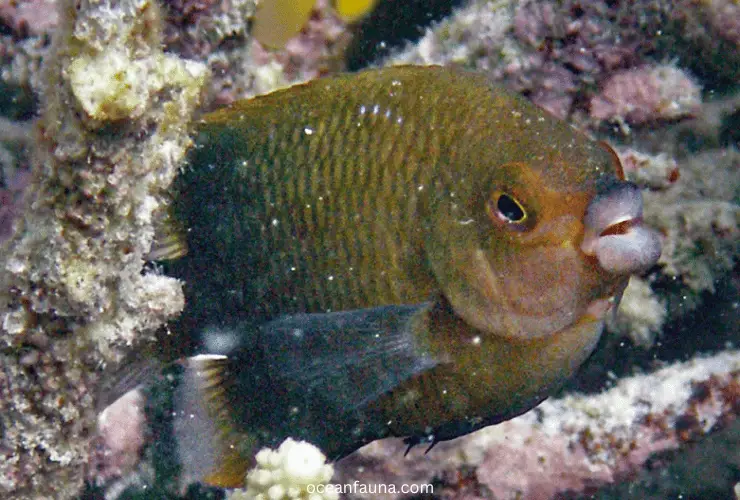
The big-lip damselfish, or Neopomacentrus voluptuous as it is called by scientists, is a small, colorful fish that lives in the Indo-Pacific area. These fish are characterized by their large fleshy lips, which give them their name.
Their vibrant blue and yellow coloring makes them a popular species for aquariums. These fish are mainly herbivorous and feed on algae and small invertebrates. They have been known to use rocks to crack open shells and access prey.
Big-lip damselfish are known to form monogamous pairs and can be territorial, especially during the breeding season. They are hardy and easy to care for in an aquarium as long as they have enough places to hide and the right food.
Carp
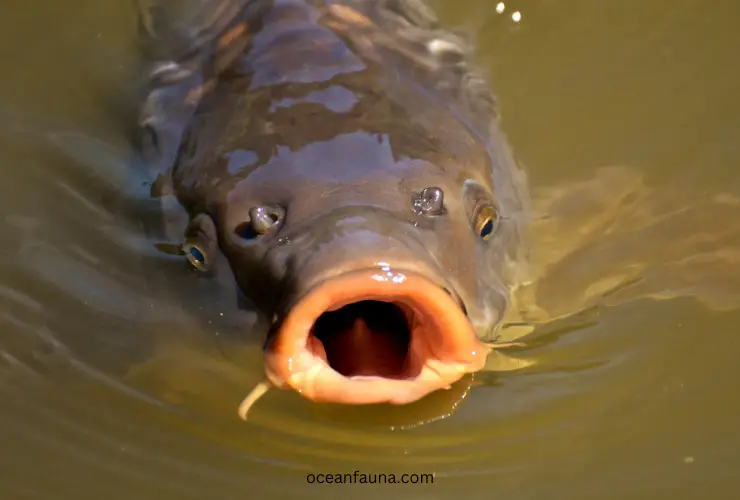
Carp, scientifically known as Cyprinus carpio, is a freshwater fish species that are widely distributed all over the world. They are native to Asia, particularly in China, and have been introduced to various parts of North America, Europe, and Australia for food and sport.
Carp has oval-shaped bodies with a dorsally located mouth and long forward-pointing barbels near the upper lip. The dorsal fin is large and has two parts, with the first part being composed of sharp spines known to be dangerous to handle. Carp is usually scaled, although some varieties are scaleless.
Nonetheless, introducing carp to certain ecosystems has sparked a number of ecological worries. Omnivorous by nature, carp may wreak havoc on aquatic vegetation and detrimentally affect native fish populations.
To curb the spread of this species, authorities have implemented various measures, including electric barriers as well as the elimination of invasive plants in these areas.
Flowerhorn Fish
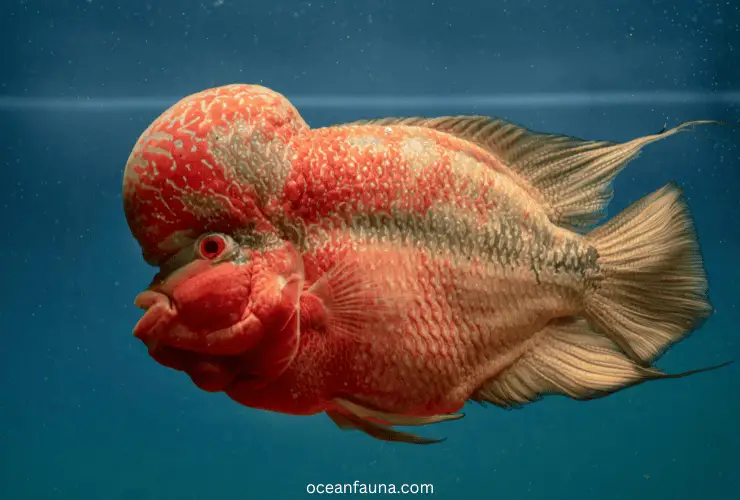
The Flowerhorn fish, also known as the Luo Han fish, is a unique and popular aquarium fish that is native to the cichlid family. This fish is the result of crossbreeding different species of South American cichlids and is known for its striking appearance and strong personality.
Flowerhorn fish come in a variety of colors, including red, orange, yellow, and blue, and can have intricate markings such as stripes and spots. They have a distinctive hump on their forehead, which is believed to be a sign of good fortune in many Asian cultures. Also, its lips and fins are usually large in size, giving it an almost lion-like look.
Flowerhorn fish are omnivores and require a balanced diet of both plant and animal matter. They should be fed high-quality fish food supplemented with live or frozen foods such as brine shrimp, bloodworms, and krill.
Gourami
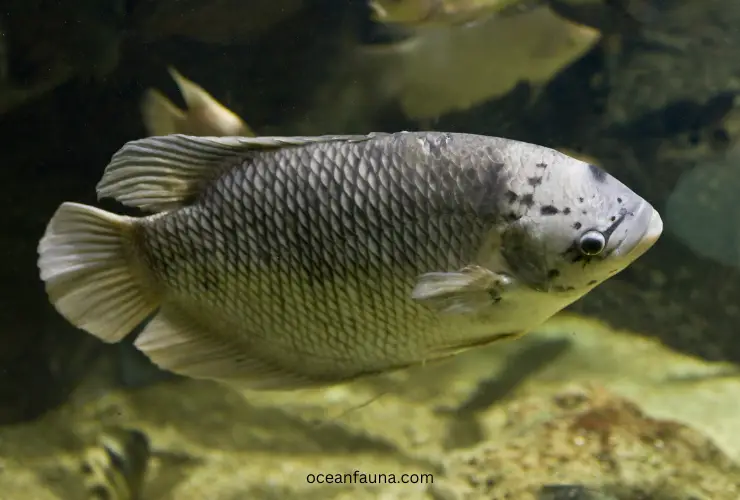
Gourami is a species of freshwater fish that belongs to the family Osphronemidae. It is commonly found in Southeast Asia, particularly in Thailand, Indonesia, and Malaysia. They are popular aquarium fish due to their vibrant colors, easy-going nature, and ability to adapt to different water conditions.
In terms of physical features, gouramis have a unique labyrinth organ, which allows them to breathe air from the surface of the water. This is particularly useful for gouramis living in shallow waters with low oxygen levels. They also have elongated fins, which contribute to their beautiful and graceful appearance.
Their big lips and eyes give them a friendly expression, which can make them an attractive addition to any home aquarium. Gouramis are peaceful fish that do not compete for food or space with other species. They generally prefer slow-moving waters, so they should be kept in tanks with low water flow.
Gouramis are omnivorous, meaning they eat both plants and animals. They feed on a variety of food, including fish flakes, live foods like worms and brine shrimp, and even vegetables like cucumber and zucchini. They are also known for their ability to jump out of the water, particularly during feeding time.
Humphead Wrasse
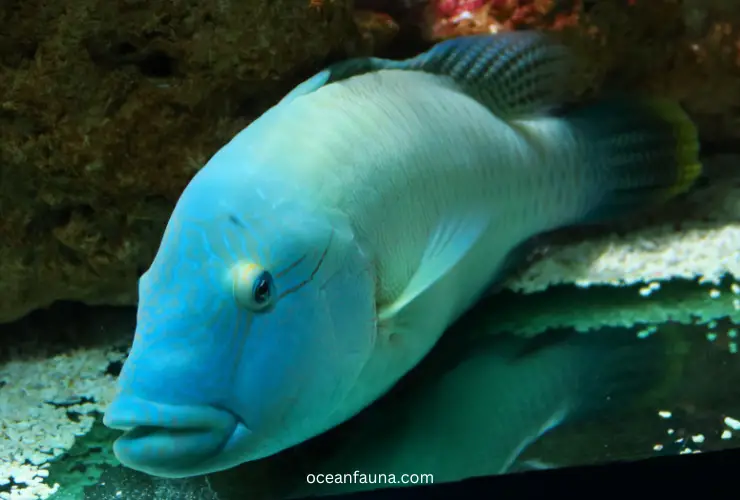
The Humphead Wrasse, also known as the Napoleon Wrasse or Maori Wrasse, is a large and highly prized fish species that inhabit the coral reefs of the Indian and Pacific Oceans.
With a distinctively large hump on its forehead, bigger lips, and a sleek, elongated body that can grow up to 7 feet long, the Humphead Wrasse is a majestic sight to behold.
Despite its impressive size and beauty, the Humphead Wrasse is currently endangered due to overfishing and habitat destruction.
Humphead Wrasse is an opportunistic feeder with a diet that includes a variety of crustaceans, mollusks, and other fish. As apex predators, they help control populations of smaller fish and keep coral reefs healthy by grazing on algae that can overgrow and smother coral.
Koi
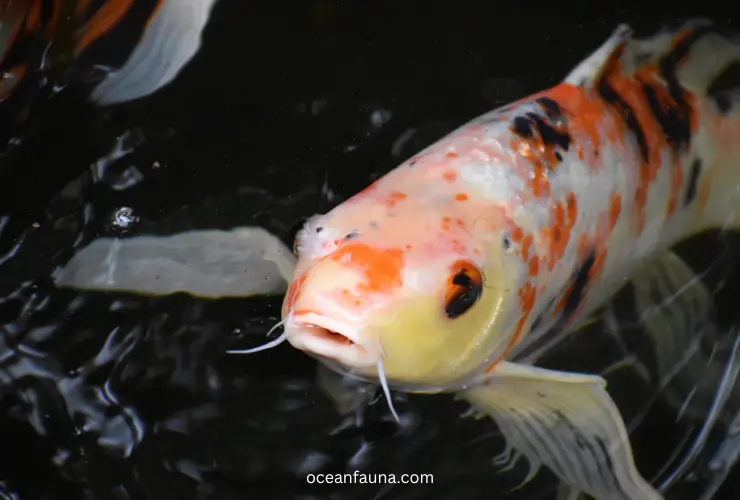
Koi, scientifically known as Cyprinus carpio, is a type of fish that originates from China and has been selectively bred for centuries to develop its distinct color patterns.
They are a popular ornamental fish, often found in backyard ponds and water gardens around the world. Also, they are omnivorous, feeding on both plants and animals and are known for being hardy and adaptable.
Koi come in a variety of colors and patterns, with some of the most popular being Kohaku (white with red markings), Sanke (white with red and black markings), and Showa (black with red and white markings). These patterns are the result of careful breeding and can fetch high prices in the market.
Lingcod
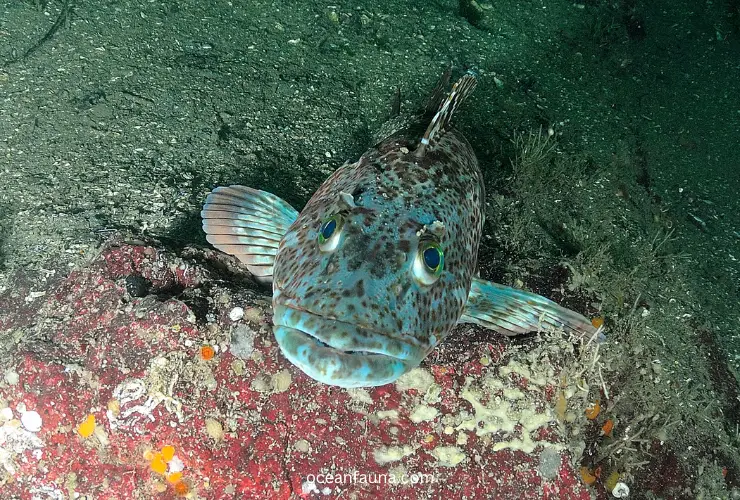
Lingcod, also known as Ophiodon elongatus, is a species of fish that can be found in the northeastern Pacific Ocean, ranging from Alaska to California, USA. It is a popular target of commercial and recreational fisheries due to its large size, firm white flesh, and mild flavor.
They have a distinctive appearance with their elongated head, wide mouth, wide lips, and sharp teeth. Their coloration varies from gray to green-brown, with irregular white blotches on their body.
Lingcod typically inhabit rocky ocean floors and subtidal reefs, and they are carnivorous, feeding on a wide range of prey such as small fish, squid, and crustaceans. They are also known for their aggressive behavior, often attacking lures and baits even when not hungry.
Pacu
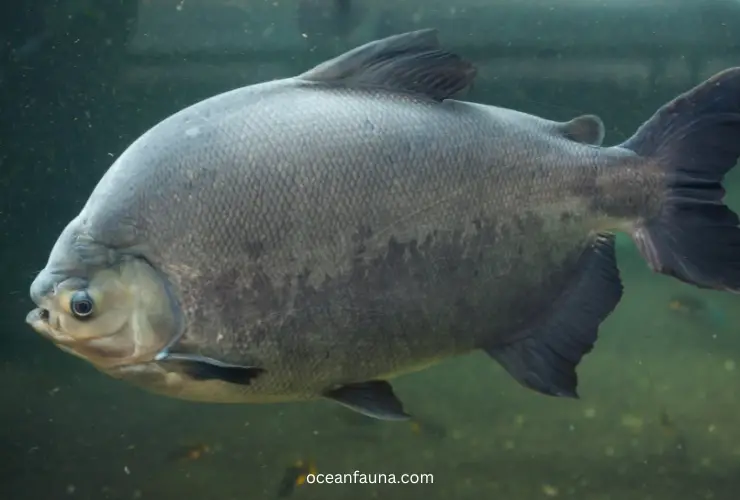
Pacu is a freshwater fish that belongs to the same family as the piranha. Native to South America, it is found in the Amazon basin and other adjacent rivers. It is a popular game fish and is known for its powerful jaws that allow it to crush hard-shelled food items such as nuts and seeds.
They are opportunistic feeders, and their diet consists of fruits, nuts, and seeds that fall from trees into the water, as well as smaller fish and invertebrates.
The Pacu is typically a shade of brown, growing up to an impressive 3 feet 6.5 inches in length and weighing as much as 88 pounds.
Their flattened bodies and large, powerful fins make them excellent swimmers. They are social animals and can be found in schools of up to 30 individuals, although they prefer to seek out more secluded areas when they are feeding or resting.
Paddletail Snapper
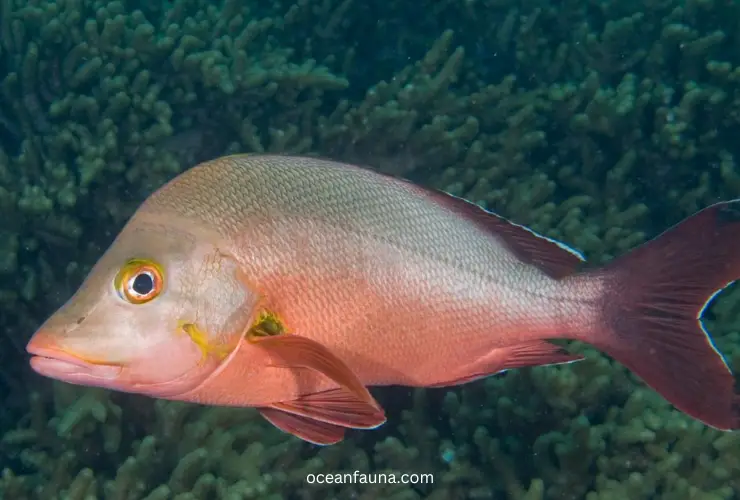
The Paddletail Snapper, also known as the Blue-lined Snapper, is a species of fish found in tropical waters around the world. These fish are named after their distinctive blue stripes that run vertically down their bodies, creating a paddle-like appearance. They belong to the family Lutjanidae and can grow up to 50 cm. in length.
Paddletail Snappers are typically found in coral reefs, where they feed on small fish, crustaceans, and mollusks. They are known for their strong teeth and powerful jaws, which allow them to crush the shells of their prey. These fish are also popular among recreational fishermen, who prize them for their fighting ability and delicious meat.
However, like many species of fish, Paddletail Snappers face overfishing and habitat destruction threats. In some areas, they are also caught as bycatch in commercial fishing operations. Conservation efforts are underway to protect these fish and ensure their long-term survival.
Parrotfish
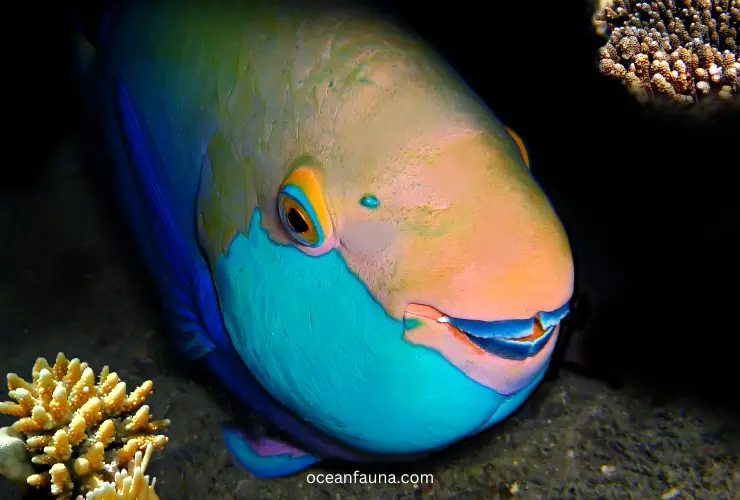
Parrotfish (Scaridae) are beautiful and colorful marine creatures that are found in tropical and subtropical waters around the world. There are about 80 species of parrotfish, varying in size from less than an inch to up to four feet long. They are named “parrotfish” because of their beak-like jaw structure, which is similar to that of a parrot.
One interesting fact about parrotfish is their ability to change color throughout their lives. Juvenile parrotfish often have bright and vibrant colors, while the colors of adult parrotfish are more muted. As they mature, parrotfish go through a process called sequential hermaphroditism, where they change from female to male. During this process, the parrotfish’s coloration also changes.
Parrotfish are an essential part of coral reef ecosystems. They feed on algae and dead coral, which helps to keep the reef healthy. They also produce a lot of sand by grinding up the coral they eat, which contributes to the formation of new islands and beach formations.
In addition to their ecological importance, parrotfish are also important in traditional medicine. In some cultures, their scales and bones are used to make medicinal remedies for various ailments.
Piranha
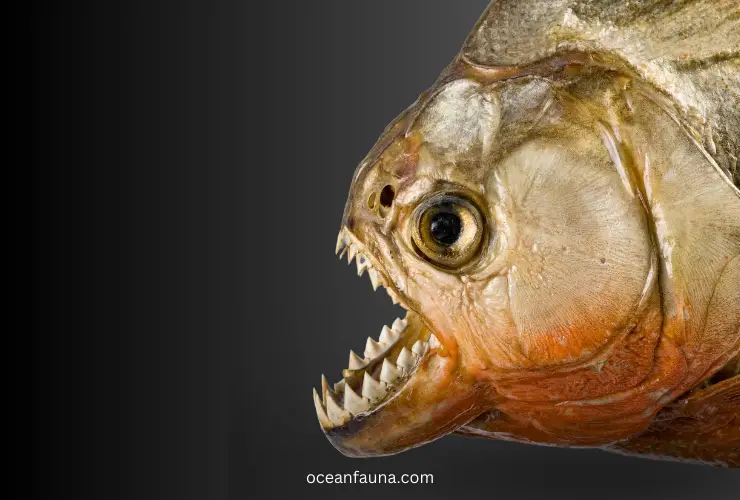
Piranhas are freshwater fish that are known for their sharp teeth and aggressive behavior. They belong to the family Characidae and are native to South America, particularly in the Amazon basin.
These carnivorous fish are often portrayed in popular media as vicious predators that attack humans and animals. In reality, piranhas are not as dangerous as they are often depicted.
While they have powerful jaws and sharp teeth that can inflict serious injuries, they prefer eating other fish, insects, and crustaceans. They also play an essential role in their environment’s food chain, maintaining populations of smaller fish.
Their big lips and flat heads help them to detect prey in murky waters, while their large fins allow them to swim quickly through the water. Their social behavior also helps them to hunt effectively. They often travel in large schools of up to 100 individuals and can be seen swimming in circles and darting after prey.
There are over 30 species of piranhas, each with its own unique characteristics. Some species are more aggressive and territorial than others, and some are smaller and less dangerous. The red-bellied piranha is perhaps the most well-known species, with its distinctive red coloring and reputation for being a fearsome predator.
Pufferfish
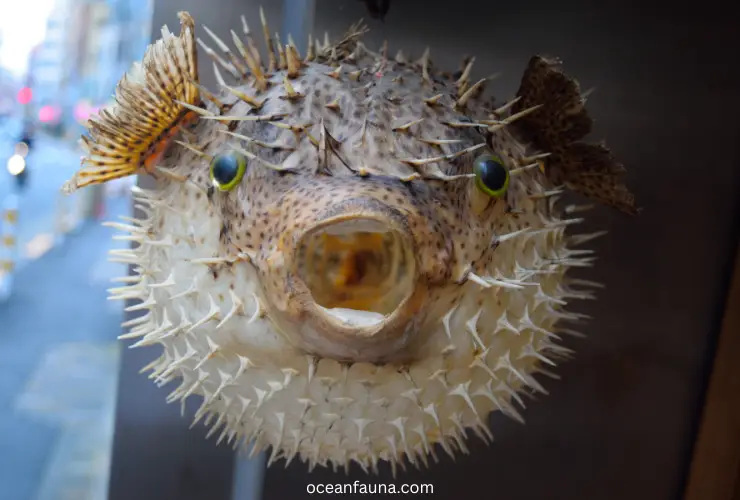
Pufferfish, also known as blowfish, is a type of fish that is found in tropical waters all around the globe. There are over 120 different species of pufferfish, each with its unique characteristics and size.
One of the most distinctive features of pufferfish is its ability to inflate its body to several times its normal size. By swallowing large amounts of water or air, pufferfish can transform into a ball-like shape designed to scare off predators. They can also puff up their spines, making them almost impossible to swallow.
Pufferfish is also well-known for its toxic flesh. Some species of pufferfish contain tetrodotoxin, a potent neurotoxin that can cause paralysis or even death when ingested by humans.
Despite this, pufferfish is considered a delicacy in some parts of the world, particularly in Japan, where it is prepared by trained chefs who know how to safely remove the toxic parts of the fish.
Queensland Grouper
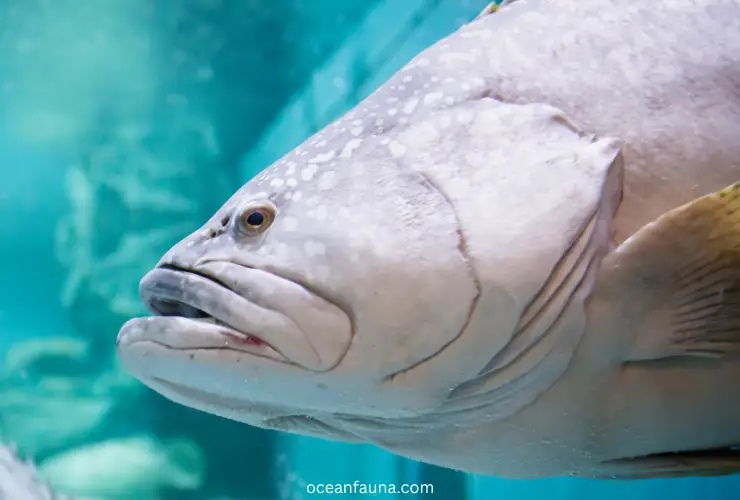
The Queensland Grouper, also known as the giant grouper, is a species of fish that can be found in the waters of the Indo-Pacific region, particularly in the coral reefs of Australia’s Great Barrier Reef.
The Queensland Grouper has a distinct appearance: a broad head and mouth, big lips, large eyes, and a rounded tail. It has a dark brown or greyish-brown color with irregular black or dark brown blotches on its body.
Juvenile Queensland Groupers have a more vibrant color and pattern, with a yellow or white base color and vertical brown or black stripes on their bodies.
The Queensland Grouper is a slow-moving and solitary fish that prefers to live in rocky areas and caves. As a top predator, it preys on a variety of fish, crustaceans, and even small sharks.
The Queensland Grouper is a culturally and economically valuable species, particularly in Australia, where it is known as the Queensland groper or Queensland cod.
However, the species has been listed as vulnerable in some parts of its range due to overfishing and habitat degradation.
Red Shoulder Peacock Cichlid
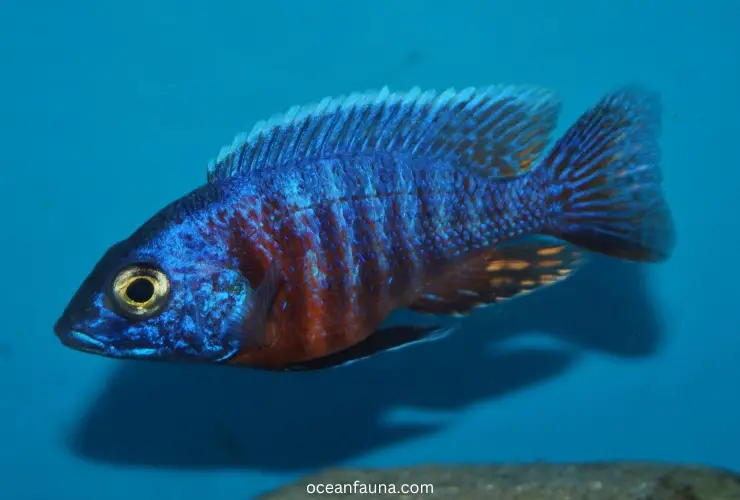
The Red Shoulder Peacock Cichlid (Aulonocara stuartgranti) is a beautiful and popular fish species that belong to the family Cichlidae. This fish derives its name from the striking red coloring that is present on its shoulders. They are native to Lake Malawi, which is located in East Africa.
Adult Red Shoulder Peacock Cichlids can grow to be around 6 inches in length, and they are sexually dimorphic. This means that males and females have different appearances, with males being more brightly colored and displaying larger fins. The males also tend to develop a nuchal hump on their forehead as they mature.
In terms of diet, these fish are omnivorous and will eat a variety of foods. Their diet can include live, frozen, or prepared foods such as flakes or pellets. Providing them with a balanced diet that includes a mix of protein and vegetable matter is essential.
Red Snapper
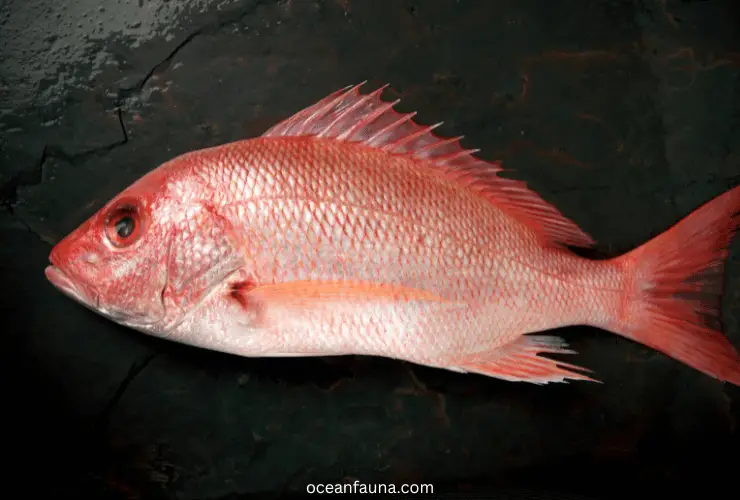
Red Snapper (Lutjanus campechanus) is a type of fish found in the Gulf of Mexico, specifically in the Atlantic Ocean and the Caribbean Sea. It is a popular fish for commercial and recreational fishing alike due to its tender, sweet meat, and large size.
Red Snapper can grow up to 40 inches in length and can weigh up to 50 pounds. They are typically found near the ocean floor and feed on a variety of crustaceans and other small fish. The fish has a reddish hue on its scales, hence the name “red snapper.”
Saltwater Angelfish
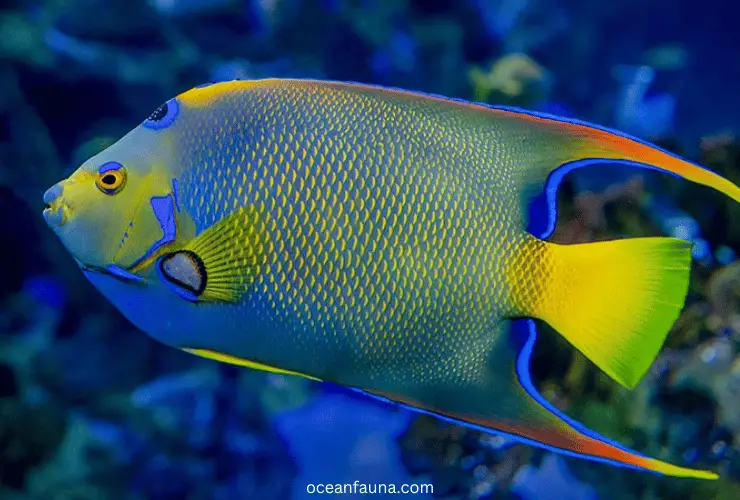
Saltwater angelfish, also known as pomacanthidae, is a family of marine fish that inhabit coral reefs and rocky crevices in the tropical Atlantic, Pacific, and Indian Oceans. With their vibrant colors and striking patterns, these fish are highly sought-after by both hobbyists and collectors.
In terms of appearance, saltwater angelfish are medium to large in size and have a disc-shaped body with long, broad lips and flowing fins. Their colors range from vivid blues, yellows, and oranges to more muted browns and grays. Some species also have distinctive markings, such as stripes or spots.
While there are over 80 species of saltwater angelfish, they all share some common traits. For example, they are carnivorous and feed on a range of small creatures, including crustaceans, mollusks, and small fish. They are also reef-safe, meaning they will not harm other reef inhabitants like coral or anemones.
Scorpionfish
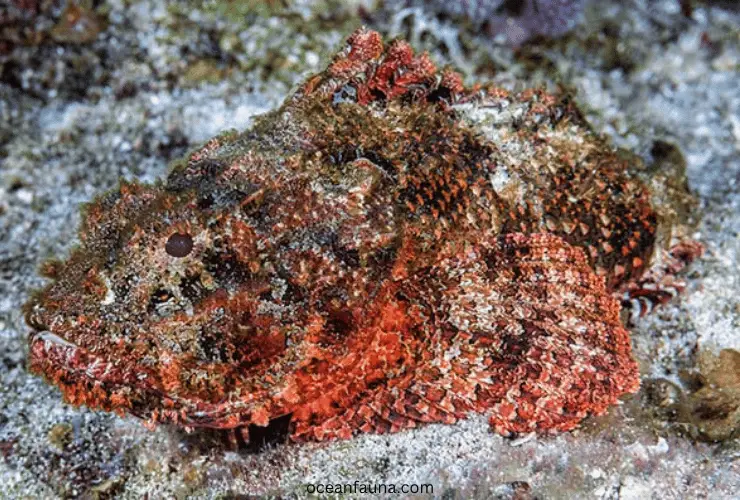
Scorpionfish, also known as Scorpaenidae, are a family of fish that are widely distributed across the world’s oceans, from the tropical waters of the Indo-Pacific region to the colder waters of the North Atlantic. These fish are known for their venomous spines, which they use for defensive purposes.
The scorpionfish has a distinctive body shape, with a large head and a broad mouth that enables it to capture prey items efficiently. They have a wide variety of colors and patterns, including mottled patches of red, orange, brown, and white, making them highly camouflaged and difficult to spot.
They are also highly predatory, feeding on a variety of prey items, including small fish, crustaceans, and cephalopods.
The venom of the scorpionfish is highly toxic and can be lethal to humans. It is injected through the fish’s spines, which are located on their fins and along their back. The venom can cause severe pain, swelling, and redness at the site of the sting and can also lead to more serious complications, such as respiratory failure and paralysis.
Despite their venomous spines, scorpionfish are a popular game fish and are sought after by anglers for their aggressive behavior and challenging fight.
Sweetlips Fish
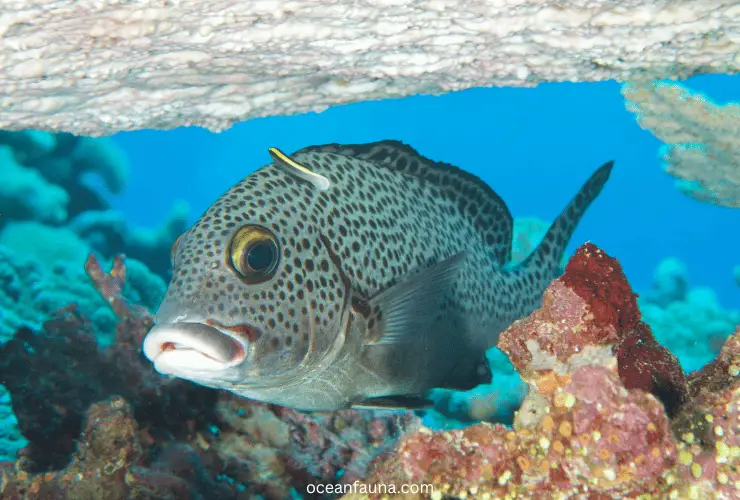
Sweetlips fish refer to a group of various species of bony fish that belong to the family Haemulidae. These fish are typically found in tropical and subtropical regions, especially in the Indo-Pacific region. The name “sweetlips” refers to their large, fleshy lips that resemble a smiling expression.
Generally, sweetlips have elongated bodies and flattened heads with eyes that are situated at the top of their heads. They are usually found in coral reefs and rocky areas and can range in size from just a few inches to over two feet in length.
Triggerfish
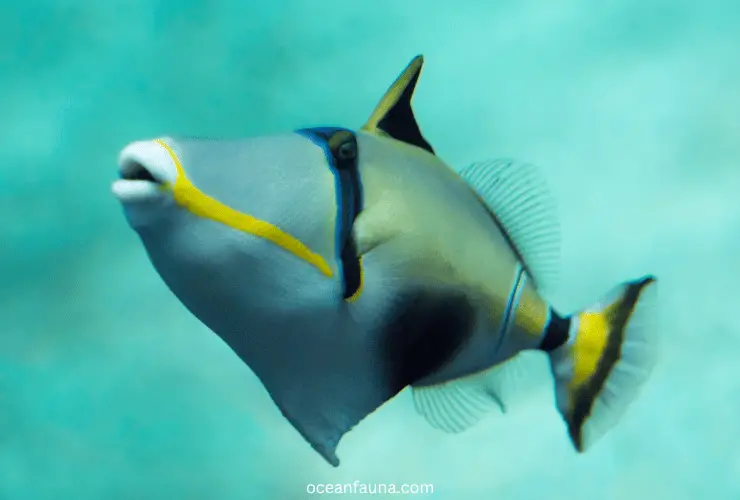
Triggerfish, also known as the Balistidae family, is a species of marine fish known for their unique look and impressive swimming abilities. These fish are found in warm waters around the world, including the Caribbean, the Pacific, and the Indian Ocean.
Triggerfish are known for their distinctive, flattened bodies, wedge-shaped heads, and bigger lips. They often have bold, colorful patterns and markings, making them popular among aquarium enthusiasts.
Triggerfish have mighty jaws that they use to feast on a range of foods, including crustaceans, mollusks, and sea urchins.
Wolf Fish
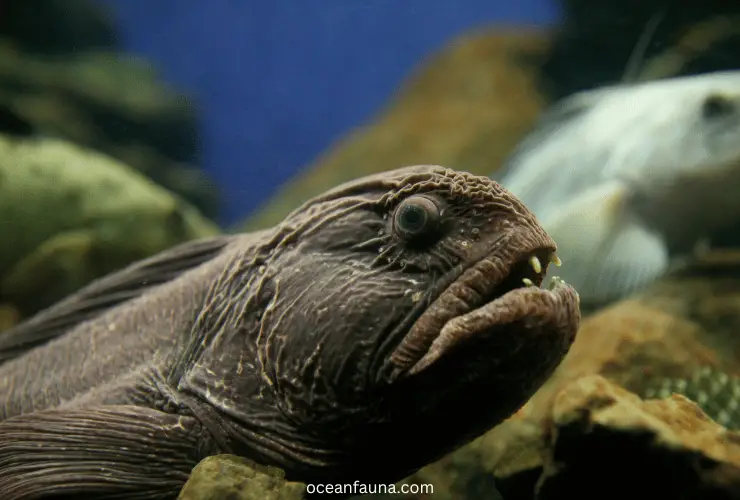
The Wolf fish, also known as the ‘devil fish’ due to its appearance, is a freshwater fish species found in South America.
It is known for its fierce predatory behavior and sharp teeth, which it uses to feed on a variety of prey, including fish and crustaceans. Some species can grow to be quite large, reaching lengths of up to 150 cm and weighing up to 22 kg.
Their powerful jaws and teeth allow them to exert a force of up to 1,400 newtons, making them one of the strongest biters among fish species. They are also known for their unique respiratory system, which allows them to breathe air in oxygen-depleted environments, facilitating their survival in harsh conditions.
Conclusion
Now you have a detailed list of the 20 fish with big lips. Their big lips help them to capture food and defend themselves from predators. Also, all these fish species have unique features and behaviors that make them stand out in marine and freshwater environments.
While some are popular game fish, others are known for their venomous spines or powerful jaws. Knowing more about these species can help us appreciate their beauty and diverse adaptations in the wild.


1 thought on “20 Fish With Big Lips: Detail Explanation With Image”